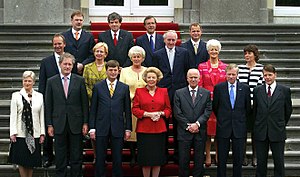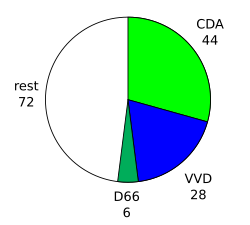
Back Balkenende II-kabinet Afrikaans Kabinett Balkenende II German Cabinet Balkenende II French Kabinet Balkenende kedua ID Governo Balkenende II Italian Kabbinèt-Balkenende II LI Kabinet-Balkenende II Dutch Drugi rząd Jana Petera Balkenende Polish
Second Balkenende cabinet | |
|---|---|
Cabinet of the Netherlands | |
  The installation of the second Balkenende cabinet on 27 May 2003 | |
| Date formed | 27 May 2003 |
| Date dissolved | 7 July 2006 (Demissionary from 30 June 2006) |
| People and organisations | |
| Head of state | Queen Beatrix |
| Head of government | Jan Peter Balkenende |
| Deputy head of government | Gerrit Zalm Thom de Graaf (2003–2005) Laurens Jan Brinkhorst (2005–2006) |
| No. of ministers | 16 |
| Ministers removed | 4 |
| Total no. of members | 18 |
| Member party | Christian Democratic Appeal (CDA) People's Party for Freedom and Democracy (VVD) Democrats 66 (D66) |
| Status in legislature | Centre-right Majority government |
| History | |
| Election | 2003 election |
| Outgoing election | 2006 election |
| Legislature terms | 2003–2007 |
| Incoming formation | 2003 formation |
| Outgoing formation | 2006–2007 formation |
| Predecessor | First Balkenende cabinet |
| Successor | Third Balkenende cabinet |
| Part of the Politics series |
![Azure, billetty Or a lion with a coronet Or armed and langued Gules holding in his dexter paw a sword Argent hilted Or and in the sinister paw seven arrows Argent pointed and bound together Or. [The seven arrows stand for the seven provinces of the Union of Utrecht.] The shield is crowned with the (Dutch) royal crown and supported by two lions Or armed and langued gules. They stand on a scroll Azure with the text (Or) "Je Maintiendrai" (French for "I will maintain".)](http://upload.wikimedia.org/wikipedia/commons/thumb/8/8f/State_coat_of_arms_of_the_Netherlands.svg/150px-State_coat_of_arms_of_the_Netherlands.svg.png) |
|---|
|
|
The second Balkenende cabinet was the executive branch of the Government of the Netherlands from 27 May 2003 until 7 July 2006. The cabinet was formed by the Christian-democratic Christian Democratic Appeal (CDA), the conservative-liberal People's Party for Freedom and Democracy (VVD), and the social-liberal Democrats 66 (D66) after the election of 2003. The cabinet was a centre-right coalition and had a slim majority in the House of Representatives with Christian Democratic Leader Jan Peter Balkenende serving as Prime Minister. Liberal Leader Gerrit Zalm, a former Minister of Finance, served as Deputy Prime Minister and returned as Minister of Finance, while former Progressive-Liberal Leader Thom de Graaf served as Deputy Prime Minister and Minister without Portfolio for the Interior.
The cabinet served during the unstable 2000s. Domestically, immigration was a major point of attention and it had to deal with the murder of controversial filmmaker and critic Theo van Gogh, while internationally, it dealt with the war on terror and the government support for the Iraq War. The cabinet suffered several major internal and external conflicts including multiple cabinet resignations, such as that of Deputy Prime Minister De Graaf following the failed introducing of a new referendum system. The cabinet fell prematurely on 30 June 2006 after the Democrats 66 supported a motion of no confidence against Immigration Minister Rita Verdonk and withdraw its support with the Democrats 66 cabinet members resigning on 3 July 2006 and the cabinet continuing in a demissionary capacity until it was replaced by the caretaker third Balkenende cabinet on 7 July 2006.[1]
- ^ "Dutch Coalition Government Falls After D66 Withdraws". Bloomberg. 29 June 2006.